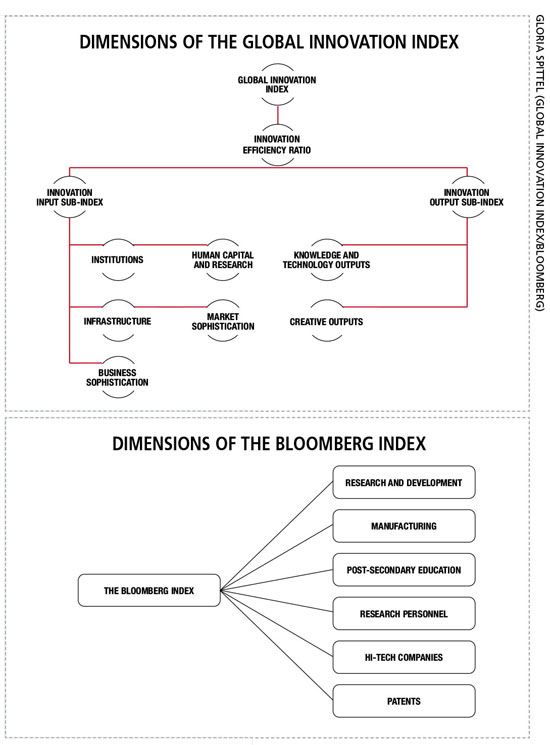THE KNOWLEDGE ECONOMY

INNOVATION-LED DEVELOPMENT
Gloria Spittel outlines the prospects and challenges for innovation in Sri Lanka

Can a country be defined as innovative? Perhaps the origin of innovation doesn’t necessarily matter in and of itself, but it does become important as the relevant processes could lead to various economic and social benefits at the local, regional and global levels.
So innovation is a priority for governments across the globe as it could provide the impetus for a turnaround in the global economy. For developing nations, innovation – technological and otherwise – has often been touted as a panacea for all ills.
But is the medicine easy to swallow?
In my research for this article, an interesting find were two different indices ranking two different nations as the world’s most innovative country or economy: the Global Innovation Index (GII), which ranks Switzerland as the most innovative nation on Earth; and The Bloomberg Innovation Index, which awards top honours to South Korea as the world’s most innovative economy.
These indices categorically answer the opening question with a resounding ‘yes.’ The GII is a composite index based on two sub-indices that measure innovation input and output while Bloomberg’s index has six main indicators.
Common to both these indices are innovation indicators such as educational institutions – especially tertiary education, research and development, knowledge and technological products, and government regulations (although in The Bloomberg Innovation Index, this is not measured but only stated as an important contributor to innovation).
The indicators of both indices provide a road map for countries to inform and build their innovation initiatives and policies. Only the four common indicators of both indices are discussed below.
In Sri Lanka – which ranks at No. 91 in the GII – each of the common indicators of both indices is both a prospect and challenge for pursuing innovation.
On the surface, education in Sri Lanka should not appear to be a challenge: the number of literate people in the country remains high with access to schooling at primary and secondary level being sufficient, although ease of accessibility should be improved.
As commonly known though, tertiary education is a dripping wet blanket in the way of progress.
The woes that surround tertiary education are many – they include underfunding, insufficient physical capacity, outdated infrastructure and to a lesser extent politicisation of the student body.
Some would suggest that the politicisation of the student body is a rather destabilising force at the tertiary level, especially considering protests at government initiatives to establish private universities in the country.
However, the right to protest and gather cannot be viewed as an outright negative given the state’s funding and management of universities. It is left to be seen whether student body protests against private universities would be as divisive as they have been in the recent past if universities were funded to develop organically.
Yet, education in Sri Lanka does offer the country a positive indicator on which to build.

Implementing future-focussed syllabi; increasing class participation, industry immersion and participation; and introducing creative-based pedagogical methods could further help mould and develop the intrinsic talent and skills students possess.
Research and development is tied to tertiary education, but private and public institutions can play a major role too. The main challenge for both tertiary and public institutions is inadequate funding and infrastructure.
While it is difficult to surmise, there’s a shortage of research personnel for both public and private institutions, and incentives to attract and retain knowledge leaders may be hard to come by. Yet, even with limitations in the ambits of these institutes, knowledge, creative and technological products – while not mainstream – are being developed.
Knowledge, creative and technological products require a solid intellectual foundation, intellectual property laws, and access to affordable and relevant knowledge. Not to flog a dead horse, but funding is a problem yet again!
Of course, in large profit-making organisations, access to knowledge databases such as industry-related peer-reviewed articles in journals or other white papers may be more within reach than at the state or public level. But this is a deterrent to standing on the shoulders of giants.
Both a prospect and challenge in every sense of the word are Sri Lanka’s leading industries – tea and apparel. These two industries offer areas for developing knowledge and technology-based creative products that can be utilised for income generation across borders, bringing in both revenue and reputation for the nation.
How the government develops and maintains an environment for innovation that includes factors such as a favourable regulatory and business environment, and a stable political environment, isn’t difficult to imagine. But more than other factors, this is a challenge given the propensity of incoming governments to undo existing facilities by either reducing or cutting funding.
Moreover, the amount of time that is taken to implement necessary reforms to build and strengthen a knowledge economy could be frustrating for those who are keen on getting a move on.




Leave a comment